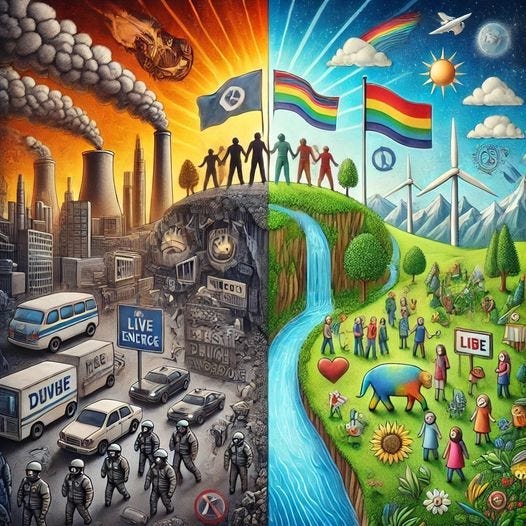The Singularity & Project 2025
Project 2025 and Trump’s Vision, or a Progressive Approach
The singularity is a hypothetical future point where technological growth becomes uncontrollable and irreversible, resulting in unforeseeable changes to human civilization. This concept is often associated with advancements in artificial intelligence (AI), where AI surpasses human intelligence, leading to exponential progress in various fields. As we approach this singularity, we should focus on ethical considerations, responsible AI development, and robust regulatory frameworks to ensure that these advancements benefit humanity as a whole.
The timeline for reaching the singularity is uncertain, but many experts project that it could occur between 2040 and 2050, with some predicting it might happen by the end of the century. However, we believe it has already begun with the rapid advancements in technology, and we are in the very beginnings of this transformation. We expect to be in full swing by 2030. This emphasizes the need for immediate and ongoing preparation to navigate the profound implications of this transformative period.
The question of which ideology — Project 2025 and Trump’s vision, or a progressive approach — has a better chance of succeeding in an upcoming socioeconomic wave of the singularity is complex and depends on various factors including technological advancements, societal values, economic conditions, and political dynamics.
Here are some key considerations for each ideology:
Project 2025 and Trump’s Vision: Key Characteristics:
Conservative and Nationalist Policies:
Focus on traditional values, national sovereignty, and reduced reliance on international institutions.
2. Emphasis on deregulation, tax cuts, and reducing the size of government.
Economic Policies:
Promotion of free-market principles, support for fossil fuel industries, and deregulation of environmental protections.
2. Policies aimed at boosting domestic manufacturing and reducing trade deficits.
Social Policies:
Conservative stance on social issues such as immigration, LGBTQ+ rights, and reproductive rights.
2. Emphasis on law and order, strong national defense, and limiting the influence of what they perceive as liberal bias in media and education.
Potential Strengths:
Economic Growth: Deregulation and tax cuts could spur short-term economic growth and business investment.
National Security: Strong focus on national defense and border security might appeal to voters concerned about security and sovereignty.
Potential Weaknesses:
Environmental Impact: Deregulation and support for fossil fuels could exacerbate climate change issues.
2. Social Division: Conservative social policies might deepen societal divisions and alienate marginalized groups.
Progressive Ideology: Key Characteristics:
Liberal and Inclusive Policies:
Emphasis on social justice, equality, and inclusion.
2. Support for international cooperation and multilateralism.
Economic Policies:
Focus on green energy, climate change mitigation, and sustainable development.
2. Support for social safety nets, universal healthcare, and progressive taxation.
Social Policies:
Advocacy for LGBTQ+ rights, gender equality, and reproductive rights.
2. Emphasis on criminal justice reform, immigration reform, and addressing systemic racism.
Potential Strengths:
Environmental Sustainability: Strong focus on combating climate change and promoting renewable energy could lead to long-term environmental sustainability.
Social Cohesion: Policies promoting inclusivity and equality could reduce social tensions and create a more cohesive society.
Potential Weaknesses:
Economic Challenges: Progressive policies might face resistance from businesses and could lead to higher short-term costs for implementing social programs.
Political Resistance: Progressive policies might struggle to gain traction in areas with strong conservative values and could face significant political opposition.
Likelihood of Success
The success of either ideology in the context of a socioeconomic wave of singularity will depend on several factors:
Technological Advancements:
How each ideology leverages technological innovations to address economic, social, and environmental challenges.
Public Sentiment:
The extent to which the public supports the values and policies of each ideology.
Economic Conditions:
The ability of each ideology to adapt to and manage economic changes, including automation, AI, and globalization.
Political Landscape:
The ability of each ideology to navigate political opposition and build coalitions to implement their policies.
Conclusion
In an upcoming socioeconomic wave of singularity, the ideology that adapts most effectively to technological advancements, resonates with public values, manages economic transitions, and navigates the political landscape is likely to succeed. Both Project 2025 and progressive approaches have their strengths and weaknesses, and their success will ultimately depend on how well they address the challenges and opportunities presented by this transformative period.


